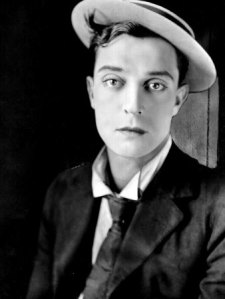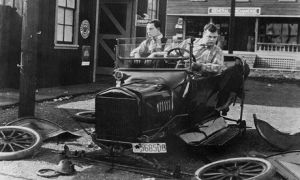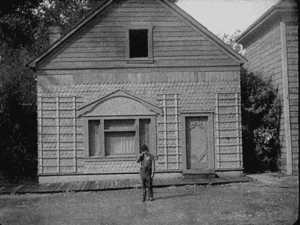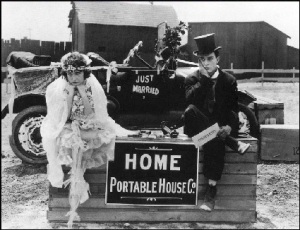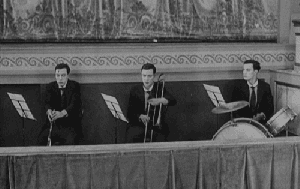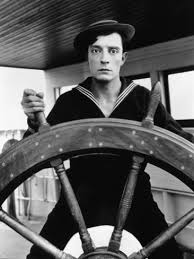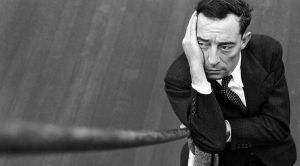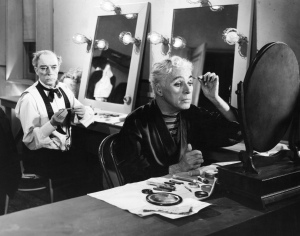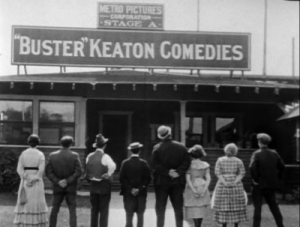Buster Keaton was a master filmmaker and comic genius. He produced, directed, acted, wrote and edited. He performed with his mother and father in Vaudeville at a very young age and had no formal education. His father even acts in many of his films. Keaton has been called The Great Stone face for his stoic facial expressions. His slap shoes and pork pie hats became his trademark. He loved to film on location and was a master of traveling shots. He was even a world class bridge player.
Keaton’s film debut was in the 1917 Roscoe “Fatty” Arbuckle film The Butcher Boy. Keaton and Arbuckle became best friends and began collaborating on films together. After a few films Keaton was co-directing. They were in 14 films together with The Garage (1920) being their last. Arbuckle left to make pictures for Paramount and Keaton got his own studio, Buster Keaton Comedies.
The General (1926) is considered one of Keaton’s greatest films. At the time it was considered a flop. In the film Keaton recreates the Civil War and some said the gags were in bad taste. There are many dangerous stunts that Keaton did himself. One of the most expensive shots of the entire silent era is at the climax of the movie when a bridge and train are destroyed. Months of planning went into the scene. The bridge was built and a real train was used for authenticity. It dropped 35 feet and people came from all around to watch it happen. At one point during filming on location in Oregon, sparks from a train engine set a forest on fire. There was so much smoke they had to return to California and wait for the smoke to clear before they could finish filming.
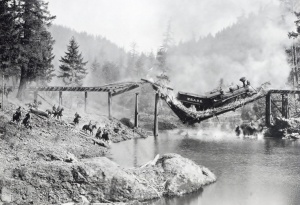 Keaton was known for his dangerous, physical stunts and in Steamboat Bill Jr. (1928) he performed his most legendary stunt. During one scene Keaton is standing in front of a two story house. The half ton house facade falls down and he is saved by a very small open window. If Buster was slightly off his mark he would have been killed. Cast and crew were literally praying for his life.
Keaton was known for his dangerous, physical stunts and in Steamboat Bill Jr. (1928) he performed his most legendary stunt. During one scene Keaton is standing in front of a two story house. The half ton house facade falls down and he is saved by a very small open window. If Buster was slightly off his mark he would have been killed. Cast and crew were literally praying for his life.
In One Week (1920), newlyweds put together a prefab house with the boxes numbered in the wrong order. In the Playhouse (1921) Buster was recovering from a broken foot and was unable to do physical comedy. Instead he played all the roles in the film with multiple exposures. The Navigator (1924) was inspired by a prop (the boat).
After Steamboat Bill Jr., Joseph Schneck sold Buster’s contract to MGM and he lost his creative independence. By this time Hollywood was controlled by the big studios. His first movie for MGM, The Cameraman (1928), would be his last great film. In 1933 MGM fired Buster. At the age of 40 Buster hit rock bottom with a nasty divorce and his power as a filmmaker being taken away by the studio. He became an alcoholic. After he sobered up MGM hired him back as a gag writer. He wrote gags for such comedians as The Marx Brothers.
When television became popular Buster re-staged all his old routines for television shows. He appeared on The Donna Reed Show, This is Your Life, The Twilight Zone and many others.
Buster stared with Charlie Chaplin one time in the film Limelight (1952).
In 1959 the Academy of Motion Pictures awarded Buster an honorary Oscar.
I think Buster Keaton had a good speaking voice. However, he was a stunt and gag man and with sound, audiences didn’t seem to appreciate it anymore. I don’t think Buster Keaton received the recognition he truly deserved until much later in life.

